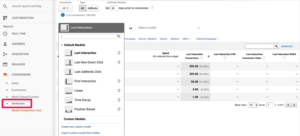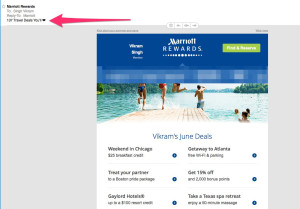Marketing success today can be measured using many diverse metrics. Analytics programs let you measure everything from who and where your website visitors come from to what content they are interested in. These engagement and conversion metrics can help you understand what is really working when it comes to your website and marketing efforts.
Some hotels have an in-house digital marketing team, but most outsource their online campaigns to an agency. Either way, these teams are usually tasked with producing an ROI (return on investment) report for every dollar spent on channels like Google AdWords, Facebook, etc. There is an industry-wide obsession with knowing where the last revenue-generating click came from. This metric invariably takes center stage in marketing meetings, ensuring that the conversation never moves beyond the last click and how much revenue was booked. Ignoring overall marketing channel performance might have worked for hotels in the good old days, but not today. A lot of hotels are struggling to understand why they are not seeing massive returns on their advertising dollars anymore. Even brand name traffic and clicks are in decline. So what has eroded your marketing campaign power?
The villain in this story – the one preventing you from moving forward – is this thing called last click attribution. It has derailed countless hotel marketing campaigns for both large and small operators. I’d like to take some time to help you understand attribution models in the hospitality and travel business, and how they affect your marketing efforts.
What Is an Attribution Model?
The good news is that most hotels and inns are spending some amount of money on digital ads. The bad news is that decision-makers have a limited understanding of how online marketing works today, and which strategies they should be crediting for the successes and failures of their campaigns.
Let’s dive right into attribution. An attribution model is a set of rules that that help you determine which touchpoints along the conversion path should be getting the credit for the final sale or conversion. Sounds simple… but it’s not. What makes it tremendously complicated in our sector is the number of touchpoints involved when someone is planning a trip, and subsequently a hotel stay.
A touchpoint is any point of contact that occurs between you and your customer; in our case, we are discussing online touchpoints. Here is a list of some of the touchpoints that might occur between your hotel and a potential guest who is planning a trip to Sydney over a period of weeks or months before visiting:
- Top-level destination research: airfare searches, Sydney travel blogs, etc.
- Neighborhood research: staying in Bondi Beach vs Central Business District vs iconic Sydney Harbor
- Hotel research: Narrowing lodging search by researching independent vs brands; top-ranking hotels for value and price on TripAdvisor; hotel websites, social media profiles, and blogs
- Things to do: online searches for top things to do in Sydney; lists and blogs about Sydney; seasonal events
- Dining: restaurants, dietary requirements and cuisine preferences, must-haves, food blogs, review websites
While the above process is happening, your guest might also encounter some of these hotel-specific marketing touchpoints:
- Hotel display ads: placed on top travel blogs and websites
- Hotel location and value Google ads: “Luxury Hotels in Sydney,” “Hotels near Sydney Harbor”
- Hotel brand name Google ads: when they search for your hotel by name
- Hotel TripAdvisor Page: while they are still researching your price and value
- Meta/OTA rate shop: your listings, reviews, and rate profile
- Hotel blog post about seasonal events: useful content on your website
- Hotel email newsletter: perhaps they sign up to stay in touch before booking or arriving the hotel
- Hotel local dining guide; return visit for more useful content on your website
- Hotel Facebook ads: and other social media ads, while scoping out your social profiles
Every single touchpoint is a crucial part of the shopper’s journey. This Expedia study showed that a typical hotel guest will visit over 38 websites before booking the room.
A typical website reservation that you are seeing today is the result of 30+ touchpoints that occurred at different stages of travel planning before the final act of booking a room. All the online channels you use today are more connected than ever; they must work together to support your goal of getting a booking. If you are only looking at where the final click came from when attributing revenue, you are missing the big picture. The very last step in a long decision-making process has not single-handedly earned the booking. It doesn’t make sense to allocate your entire marketing budget based on the last click that occurred before the booking.
So, let’s talk now about proper marketing channel attribution.
Deciphering the Attribution Models in Google
Google has been working on making attribution modeling more mainstream. In 2014, they released the Attribution Modeling Tool in Google AdWords. They actually want you to see how users interact with your ads, so you can run better campaigns. As of May 2016, you can integrate the attribution model of your choice with your conversion data and ad bids. Excellent tool for everyone involved! It’s especially helpful for the very few with “Marketing” in their job title that actually log in and work on their marketing campaigns. Of course, if you are just waiting for agency reports to drop into your inbox, you cannot witness this beauty firsthand…but at least you can make changes to the way you measure success.
Once you have decided to actively assign attribution for your paid and earned marketing efforts, you have to determine which model works best for your business. The following example illustrates how each attribution model would work for a hotel reservation with four touchpoints.
Touchpoints
- Touchpoint 1: Google PPC Ad. Guest X finds your hotel website for the first time by clicking on one of your Google AdWords campaign ads for “luxury hotels in Sydney.” They browse the website and consume your content and photos. You capture their email address (with their permission, of course).
- Touchpoint 2: Facebook Ad. Two weeks later, Guest X returns to your website, this time from a Facebook Ad about “Things to do in Sydney.”
- Touchpoint 3: Email Marketing. Five days later, you send them an email about upcoming events in Sydney and why your hotel is in the best location to enjoy them. You get a click-through.
- Touch Point 4: Direct Traffic. The next day Guest X books a room directly on your website by typing www.yourhotelname.com into the browser. Mission accomplished!
Your Attribution Options
- Last Click Attribution. The last click before booking, in this case your website’s direct traffic source, gets 100% credit for the reservation.
- First Click Attribution. The first touchpoint, your Google AdWords campaign ad for “luxury hotels in Sydney,” gets 100% credit for the reservation.
- Linear Attribution. Every touchpoint – Google AdWords, Facebook, Email and Direct – gets equal credit for the reservation (25% each).
- Time Delay Attribution. The touchpoints closest to the reservation dates get the majority of the credit. In this case, Email and Direct get most of the credit; Google AdWords and Facebook get less.
- Position-Based Attribution. The first and last touch points (Google AdWords and Direct) get 40% credit each, and the remaining 20% credit for the reservation is divided evenly between the middle touchpoints. Facebook and Email get 10% each.
- Data-Driven Attribution. This model gives credit for conversions based on the steps people have taken to find you and ultimately book a room with you. It uses data from your own account to determine which ads, keywords, and campaigns have the greatest impact on conversions. This is only available to accounts that have accumulated enough data over time. I love this model!
Where can you see all this? Oh, it’s right there in your Google Analytics dashboard! Look under Conversion > Attribution.
I have always loved GA. Here is why I think it’s better than anything fancy out there.
Why Should You Abandon Last Click Attribution?
Everyone would like to see the return on a marketing investment. It helps you justify why you did what you did, right? The cliché line “what gets measured gets done” (used by folks who love management guru books) is very hard to implement in digital marketing. I want to be clear that measurement is not the enemy here. It’s how you draw insights from the data that makes or breaks your marketing campaigns and future revenue.
Marketing budgets are already in very short supply in the hotel business. Imagine what happens when the allocation of these tiny budgets is determined solely by the last click that generated a booking. The result is apparent in hundreds of marketing reports today. It’s just not working anymore. It’s time to let go and move on.
The Booking Journey
The path to booking a hotel room today spans multiple websites and devices: online travel agents, metasearch, review sites, social media, etc. When you are dealing with 38 touchpoints, it’s not enough to look at the bottom of the funnel. Instead, ask yourself what you are doing to help your guest move through their booking journey.
Do you think your typical pay per click brand name ad “Official Website: Book Direct And Save!” helps when someone is still researching your location? No, it doesn’t!
Are you speaking with your guests on social media? Or is your Facebook strategy just serving up a“25% off for Spring Break” display ad?
What about email? Is it all about 35% off your best rates? Is that the only conversation you are having with your guests?
Focusing on the last touchpoint prevents you from helping your guests during the planning process, before they are ready to book. You are so busy moving marketing dollars to campaigns that target the last touchpoint that you never feed and fund top-of-the-funnel activities and channels. Ultimately, the volume is going to decline and you are going to end up playing the price game instead of selling value.
Underutilizing Your Marketing Arsenal and Agency
By giving 100% credit to the last click channel, you shift the focus of your marketing campaign to that one channel. All eyes are on the tool that is converting and showing a healthy return on investment. Hotel marketing agencies get stuck producing “ROI reports” to justify their existence every single month. Fixation on one channel kicks off a vicious cycle in which your revenue numbers start to decline, you fire the agency, hire a new one, repeat. This is particularly harmful if your digital assets are not in your control and you start from the bottom every time just like Sisyphus. Your website, campaigns and data need to consistently grow over time, and not get disrupted or lost when you change vendors.
Content production, photography, social media conversations, and email conversations are all part of your full marketing arsenal. Don’t go to battle with one weapon when you have a wide range of tools that allow you to target every single phase and touchpoint of the booking cycle.
Others Prosper While You Analyze
I have previously written about dinosaur metrics to avoid and super metrics to embrace. With most marketers 100% focused on the last click at the bottom of the funnel, the top-of-the-funnel playing field is wide open in the travel business. Online travel agents have done a great job of focusing on the entire travel journey. Of course, they bring tons of cash to the game and dominate paid channels…but there is a ton of work on the top of the funnel that is funded by conversions. They run, manage and curate thousands of websites that have content relating to the early stages of the travel-booking journey. As a result, they build trust and solid brand names in the travel business without owning a single bed.
When you leave opportunity on the table, someone will always be there to seize it.
Conclusion
Booking a room at a hotel, bed and breakfast, or Airbnb is a process. First comes the destination, then the location within the destination, then a price and value comparison, and finally the right user experience to complete the booking. Judging your hotel and travel marketing campaigns at the finish line incorrectly assigns all the praise and investment to one single component. In time, your super-performing touchpoint will face a decline and stop producing revenue for you on its own.
New lemons are needed to make more lemonade. Stop squeezing the life out of your campaigns by focusing on the last click.







